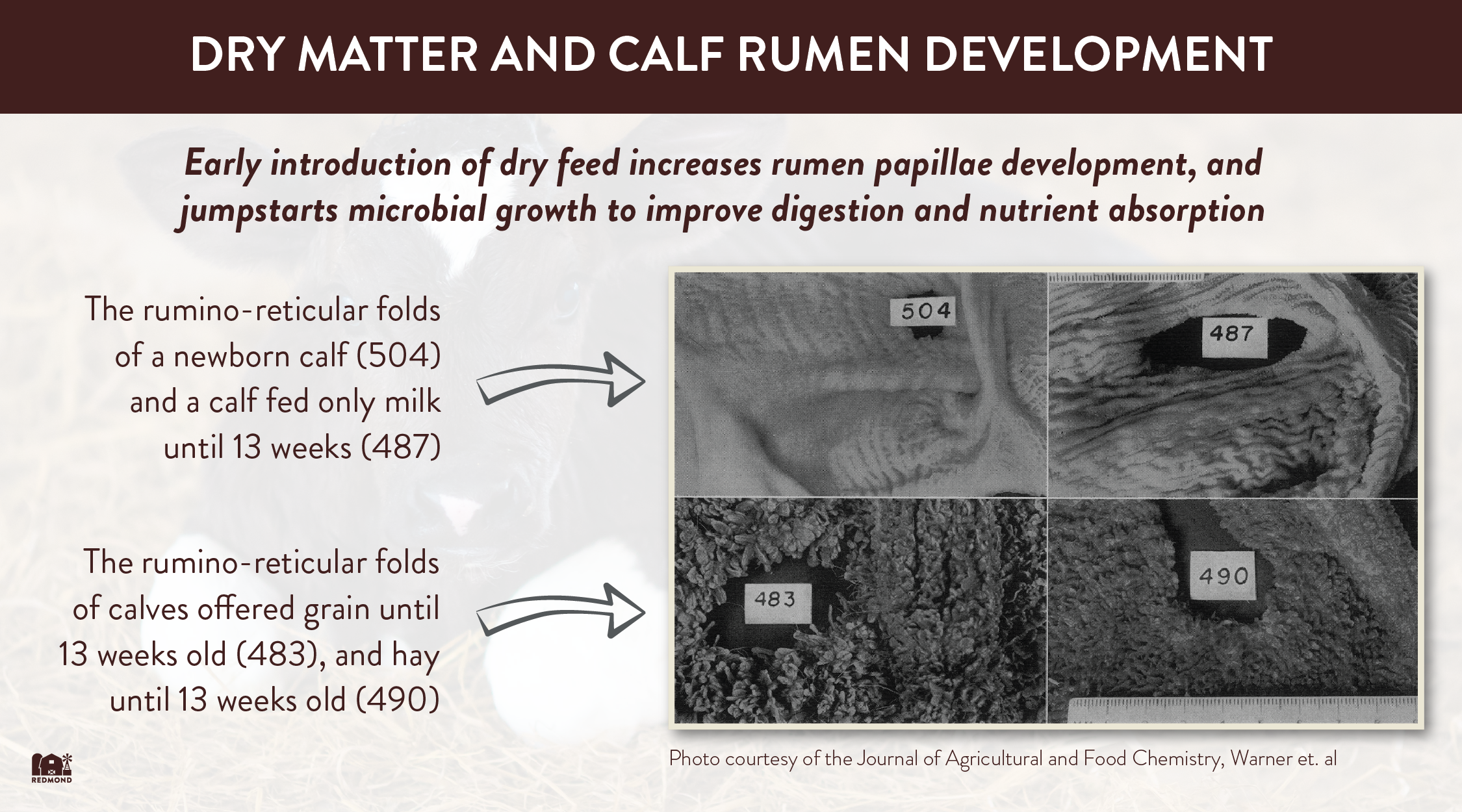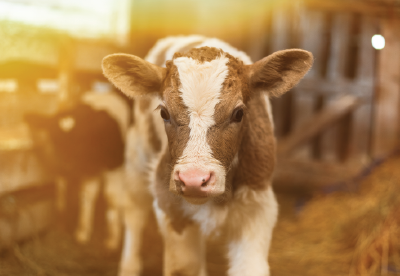Over the first month of life, your calves’ digestive system goes through quite a few changes. What you feed and how you feed it affects the microbial, muscular, and chemical transformations their rumen need as they mature. Let’s take a look at what is going on inside your calves’ digestive system during this critical first month.
The First Month of Calf Rumen Development
Even though they are born with 4 stomach compartments like all ruminants, newborn calves technically start life as “monogastic” (single stomached) animals. The first compartment they use is their abomasum, which is the largest part of their stomach during the newborn stage, about 65% of their stomach complex.
Liquid Foods (Colostrum, Milk, Replacers, Fluid Therapies)
The sucking action of nursing, either from mama or a bottle, closes off access to the other 3 compartments (rumen, reticulum, and omasum). This sucking reflex engages a special muscular channel called the esophageal groove that fast tracks colostrum, milk, replacers, and fluid therapies directly into the abomasum, bypassing all other stomach compartments.
- Click to see why colostrum in the first hour of life is so important
During these first couple weeks, the abomasum performs the bulk of the digestion as the other compartments develop. According to Michigan State University extension:
“the abomasum and small intestine secrete enzymes that are designed to digest protein, fat, and carbohydrates that can be absorbed in the small intestine.”
This fast tracked digestion can be both a blessing and a curse for little newborns. On one hand, it shortens the amount of time it takes for nutrients to be utilized by their bodies, but also makes it easier for them to get sick.
Because of how quickly and easily liquid food reaches the small intestine, and how porous their early digestive system is, newborn calves are very susceptible to harmful pathogens. Diarrheal scours are one of the most common pathogen-caused ailments for newborn calves and can lead to high death losses.
- Learn more about naturally treating and preventing scours
Fluid additive therapy can give your calves an added boost of electrolytes and probiotic colonies. There are a lot of calf fluid therapy products out there, but Redmond First Month is the only one that contains Redmond Conditioner. The smectite clay in our conditioner has been shown to help reduce calf mortality rates by 63%!
First Month is am immune stimulator that also contains natural probiotics and yeast derivatives that fortify gut health and digestive efficiency, making it the perfect immune booster for newborn calves.
Over time, the abomasum takes a back seat as the rumen and other compartments develop. After a few months it only represents 20% of the stomach capacity, and eventually 8% in mature cattle. So how does the rumen transition from an underdeveloped and bypassed stomach compartment into one of the most important organs in your calf’s body? The answer lies in dry matter.
Dry Foods and Non-suckled Liquids (Starter grains, Forage, Minerals, Water)
After a couple days of fast, rich nourishment from colostrum and milk, your calf should start trying dry food like starter grains, forage, and minerals. When the sucking reflex is not engaged, dry feed can enter the rumen and begins the critical first step of rumen development. (This also means that water drunk from troughs or buckets can also enter the rumen, since the esophageal groove does not engage).
Introducing your calves to dry feedstuff early, kickstarts rumen development and makes the weaning process much easier and less stressful for you and your animals. Michigan State University reports that:
“The consumption of dry feeds helps to inoculate the rumen with bacteria that will aid in the fermentation of the feedstuffs entering the rumen. Depending on the types of dry feeds consumed (i.e., grains vs. forage), the microbes best suited to digest those feedstuffs will populate in the rumen.”
In addition to microbial growth, small amounts of dry feed also help grow more papillae, increasing the rumen surface area for better nutrient absorption.

Slowly offering more dry feed as their rumen develops will set your calves up for greater health as they mature. Consult your veterinarian to make sure you follow a weaning schedule that meets the needs of your herd.
- Visit Penn State University to learn more about best calf weaning practices.
In addition to dry feed, calves should have early access to trace mineral salts. The craving for salty electrolytes is one of the earliest, instinctual urges animals have, making salt the best carrier for the essential trace minerals they need. To encourage good mineral eating habits early, avoid heavy mineral mixes with sweet attractants like molasses. Using higher salt to mineral ratio mixes work with your calves’ natural cravings, saves money, and results in less excreted mineral waste.
- Learn more about minerals for calves
Redmond offers a wide range of delicious mineral mixes that your calves will actually love to eat! Give us a call today at  to see how we can help nourish your calves before, during, and after the weaning process and get you back to what you love about raising animals!
to see how we can help nourish your calves before, during, and after the weaning process and get you back to what you love about raising animals!
© 2024 Redmond Minerals Inc.

